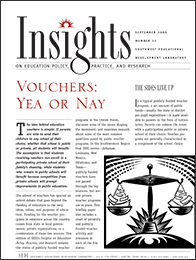Vouchers: Yea or Nay
Introduction
The idea behind education vouchers is simple: If parents are able to send their children to any school of their choice, whether that school is public or private, all students will benefit. The assumption is that students receiving vouchers can enroll in a participating private school of their family’s choosing, while students who remain in public schools will benefit because competition from private schools will prompt improvements in public education. The advent of vouchers has spurred an ardent debate that goes beyond the funding of education to the very ideas, values, and purposes of education. Funding for the voucher programs in existence across the country comes from state or local governments, private organizations, or a combination of these two sources. This edition of SEDL’s Insights on Education Policy, Practice, and Research reviews the status of publicly funded voucher programs in the United States, discusses some of the issues shaping the movement, and examines research about some of the most common questions posed by public voucher programs. In the Southwestern Region that SEDL serves—Arkansas, Louisiana, New Mexico, Oklahoma, and Texas—publicly funded vouchers have not passed through the legislatures, but several private voucher programs are in place. This briefing paper also includes a chart of privately and publicly funded voucher activity and resources in each of the five states.

Next Page: The Sides Line Up

